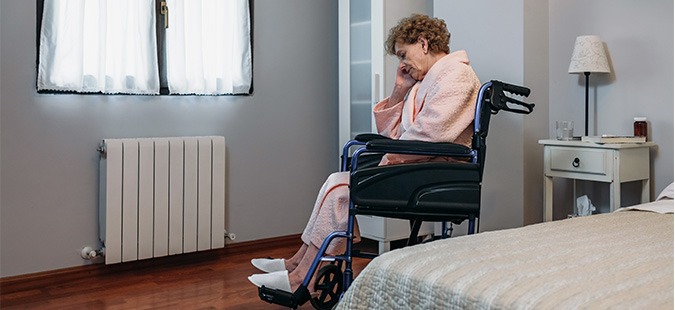
10 Red Flags You Should Never Ignore While Visiting a Nursing Home
Finding the right nursing home or long-term care facility is a challenging task with many factors to consider. You want the best care for your loved one, but you also want to protect them from the devastating effects of nursing home abuse and neglect.
Whether intentional or not, abuse can result from the ignorance of residents’ needs. Unfortunately, instances of nursing home abuse and neglect are becoming increasingly common as staffing shortages continue to impact facilities across the nation.
Nursing Home Red Flags
That’s why, when visiting different facilities, it is essential to look out for red flags or signs of possible negligence or abuse. If you notice while touring a nursing home that they have one or more of the red flags listed below, you may want to consider choosing a different facility.
1. The Facility Is Not Clean.
If the facility does not look clean, this could mean that they are understaffed or that they do not prioritize cleanliness. The common areas, restrooms, and bedrooms should always be clean and smell fresh. Unsanitary areas show laziness, and employees are inattentive to detail, integrity, and care.
2. Residents Seem Unhappy.
When touring a nursing home, look at how the residents are already cared for. Particularly look at the resident’s condition. If residents are clean, well-groomed, and generally appear happy, this is a sign that care is good.
3. Staff Turnover is High.
Not only is the look of the residents critical, but also the look and amount of staff. Employees coming and going quickly is a red flag and could mean the nursing home has poor management or practices. This could also increase the likelihood of medical errors. Additionally, ask what the ratio of staff to residents is. An understaffed business will cause neglect to the individuals that need care. If there are many residents in the building but not many employees, that’s a huge issue.
4. Call Lights are Unanswered.
A good indicator of care is by observing call lights outside or above the resident’s doors. In a long-term care facility, the call lights will inevitably go off. If you can, pick one particular light and see how long it takes before it goes off and how long it takes for someone to assist the resident.
5. There Are No Abuse Prevention Policies.
Studies show that approximately 1 in 10 seniors aged 60 and over, have faced some form of elder abuse. An ideal nursing home or long-term care facility should have abuse prevention programs. Additionally, the facility should have a complaint policy for residents or their families to let the staff know if something could be improved.
6. It Does Not Have Quality Food Services.
This requirement is often overlooked, but ensuring your facility has options for all dietary needs is essential. One of the essentials of care for older adults is a proper diet. Yet, there are reports of poor nutritional care in nursing homes across the United States. Multiple underweight residents in a facility could be a sign of negligence. Please don’t hesitate to ask for a meal calendar, and ask the staff how and where they prepare meals.
7. The Facility is Very Loud
High noise volumes and sudden loud noises can aggravate the elderly, especially ones suffering from Alzheimer’s Disease. When you tour a facility, don’t just look, but listen. Many facilities use different methods of cutting down sound. Usually, higher-functioning organizations tend to be much calmer and not as chaotic.
8. It Does Not Provide Activities Or Opportunities To Socialize.
Facilities should have some opportunity for the residents to interact with others. If the facility does not provide opportunities for the residents to be social, then they most likely are not concerned with the well-being of the residents. Another one of the most common nursing home red flags is scheduled activities. Most nursing homes have multiple monthly and weekly planned activities for residents. Activities should include outings, on-site games, lessons, arts and crafts, church services, or other activities. These activities will keep your loved ones active and exercise their bodies and minds. Don’t forget to make sure the facility’s activities are of interest to the person staying there.
9. It Does Not Have A Good Visiting Policy.
If a facility does not have a flexible visiting policy, it could sign that it is understaffed. This is something most people will overlook entirely. Does the home allow unannounced, unscheduled visits? If not, that’s a HUGE red flag. You should be free to see your family members or loved ones. Of course, there are times this is inappropriate; you should not be expecting to be able to walk right into the building at 3 am. You should expect permission to come in during regular business hours.
10. Administrators Are Inattentive
The administrator is busy, so they may not be as involved in day-to-day proceedings as regular staff members. That’s fine. However, administrators should not be completely disconnected from the residents. They need to take an active role, get to know the residents, and work hard to make the living situation the best possible.
Signs of Nursing Home Abuse
- Anxiety, confusion, and depression
- Bedsores leading to infection
- Constant physical pain
- Head injuries
- Signs of restraint, like marks on wrists
- Lack of attention to existing health issues
- Broken bones
- Malnutrition leading to weight loss
- Poor hygiene
- Unexplained loss of money or transactions
- Withdrawal from friends and family members
Tips for Finding the Right Nursing Home
Finding the right nursing home for your loved one can feel overwhelming and like all of the pressure is on you. Fortunately, there are several approaches you can take to alleviate your stress and help you make the right selection.
- Refer to nursing home ratings from federal and state agencies. Government websites like Care Compare can provide useful and credible information about nursing homes in your region. Nursing homes cited for abuse will show a white hand within a circle next to their name on Medicare.gov.
- Check out U.S. News Ratings. Over 15,000 nursing homes were assessed by U.S. News this past year and rated on short-term rehabilitation and long-term care.
- Look up online reviews. Instead of trusting testimonials in your research, use Google Reviews of real customer experiences. If you notice a pattern of negative Google reviews of a nursing home, consider avoiding the facility and looking elsewhere.
While researching the best nursing homes for your loved one can reduce the chances of nursing home abuse or neglect, the unthinkable can still happen. Many instances of nursing home abuse are unreported due to factors such as fear of retaliation, communication barriers for residents, and lack of awareness of reporting procedures. If your loved one has recently been the victim of nursing home abuse or neglect, your family deserves answers and justice. At The Goss Law Firm, we are not just your attorneys but your advocates.
Families Have The Right to Expect Quality Care
At the Goss Law Firm, we understand that abuse of our loved ones is an abuse of our trust. We know how devastating nursing home abuse is and how upset, angry, and violated you feel. Your loved one is vulnerable, and we will protect them and their rights while making their voice heard. Our skilled, dedicated nursing home abuse and neglect attorneys are here to listen to your story and help you find the necessary answers.
Contact our office today at 816-839-6452 to schedule a free, no-risk legal consultation.





